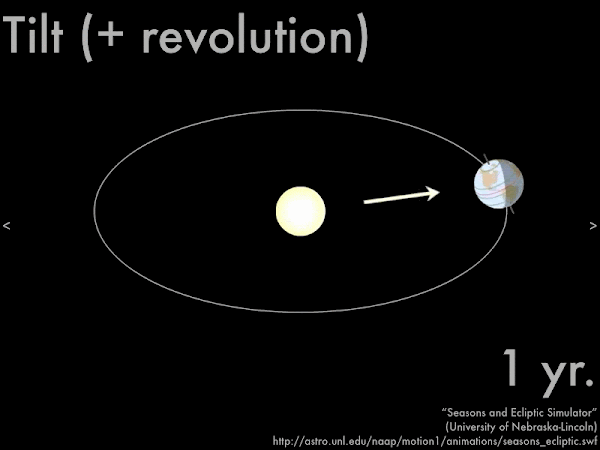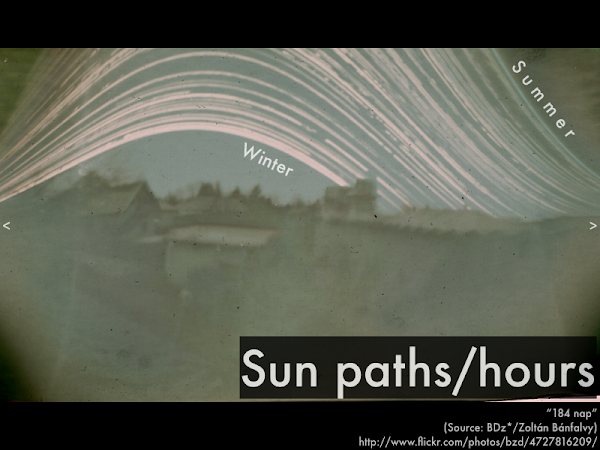 Last week we used a starwheel in order to look at the positions of stars and constellations on the celestial sphere on a given date and time. While it may seem that the stars are already against you tonight, there is a lot more going on in the sky besides the positions of stars and constellations.
Last week we used a starwheel in order to look at the positions of stars and constellations on the celestial sphere on a given date and time. While it may seem that the stars are already against you tonight, there is a lot more going on in the sky besides the positions of stars and constellations.  We'll take a look at four types of motions in the sky, with an emphasis here on distinguishing between them, and their effect on the positions of the stars and the sun. (We'll cover the motions and cycles of the moon in our next presentation.)
We'll take a look at four types of motions in the sky, with an emphasis here on distinguishing between them, and their effect on the positions of the stars and the sun. (We'll cover the motions and cycles of the moon in our next presentation.)  First, rotation.
First, rotation.

 Second, precession.
Second, precession.

Because of precession causing Earth's rotation axis to wobble, currently the star Polaris gets to be the "north star."
Eventually precession will cause the star Er Rai to be the "north star" in 4400 A.D. And yes, there will more typically be no given "north star" when the north end of Earth's axis points towards an empty portion of the night sky.
 Third, revolution. Previously you were asked to ponder the origin of the word "zodiac," or at least consider what other words it might be related to.
Third, revolution. Previously you were asked to ponder the origin of the word "zodiac," or at least consider what other words it might be related to. Like "zoo," or "zoology," the "zodiac" has something to do with animals, and is literally the "arc (or line) of animals." Traditionally there are twelve of them, but not all of them are now animals today.
Like "zoo," or "zoology," the "zodiac" has something to do with animals, and is literally the "arc (or line) of animals." Traditionally there are twelve of them, but not all of them are now animals today. 
Approximately one month later, as Earth revolves around the sun, you would then see the sun directly lining up with Libra. One month after that, then Earth revolves further around the sun such that you would see the sun directly lining up with Scorpius.

 Fourth, tilt. Which carmakers produce(d) the Solstice and the Equinox? Did any of you list these car models in your "Astronomy in the Marketplace" activity last week?
Fourth, tilt. Which carmakers produce(d) the Solstice and the Equinox? Did any of you list these car models in your "Astronomy in the Marketplace" activity last week? Pontiac made the Solstice sports coupe, and Chevrolet current makes the Equinox sports utility vehicle. (Did any of you list these astronomy-related cars in the "Marketplace Astronomy" in-class activity last week?) These are special times of year in terms of the position of the sun and the number of daylight hours, as we'll see in the in-class activity today. (The two equinoxes occur twice a year, when there are 12 hours of daylight (and 12 hours of night); the two solstices also occur twice a year, on the longest day of the year, and on the shortest day of the year.)
Pontiac made the Solstice sports coupe, and Chevrolet current makes the Equinox sports utility vehicle. (Did any of you list these astronomy-related cars in the "Marketplace Astronomy" in-class activity last week?) These are special times of year in terms of the position of the sun and the number of daylight hours, as we'll see in the in-class activity today. (The two equinoxes occur twice a year, when there are 12 hours of daylight (and 12 hours of night); the two solstices also occur twice a year, on the longest day of the year, and on the shortest day of the year.) 
So not just tilt, but revolution is needed to cause the seasons to change over the course of a year. Six months later, Earth will be over on the left side of its orbit around the sun, but as the north end of Earth's rotation axis is still pointed towards Polaris, this means that the northern hemisphere is tilted away from the sun, such that San Luis Obispo, CA in the northern hemisphere will see the sun low in in the sky, and it will be our winter.
 Here is a very long time exposure of the sun making different paths across the sky over the course of the year, which makes a high arc in the summer, when our hemisphere is angled towards the sun, and makes a low arc in the winter, when our hemisphere is angled away from the sun. We'll cover this interesting set of paths across the sky in more detail in the subsequent in-class activity today.
Here is a very long time exposure of the sun making different paths across the sky over the course of the year, which makes a high arc in the summer, when our hemisphere is angled towards the sun, and makes a low arc in the winter, when our hemisphere is angled away from the sun. We'll cover this interesting set of paths across the sky in more detail in the subsequent in-class activity today.
2 comments:
Why did the original zodiac signs stray from being "animalistic"?
Can we go more in depth in class about precession , and the difference between revolution & rotation? (Tues - Wed class)
Post a Comment